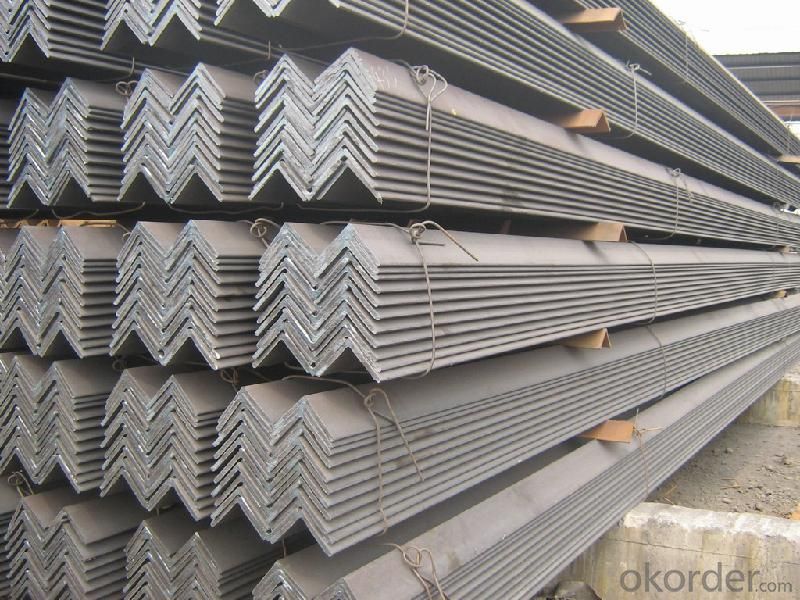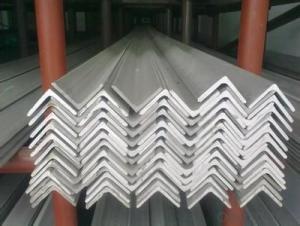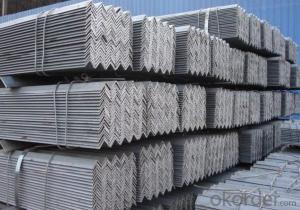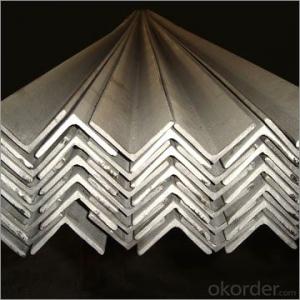Equal Angle Steel Hot Rolled ASTM A36 Hot Rolled
- Loading Port:
- Tianjin
- Payment Terms:
- TT OR LC
- Min Order Qty:
- 25 m.t.
- Supply Capability:
- 20000000 m.t./month
OKorder Service Pledge
OKorder Financial Service
You Might Also Like
Product Description:
OKorder is offering high quality Hot Rolled Steel I-Beams at great prices with worldwide shipping. Our supplier is a world-class manufacturer of steel, with our products utilized the world over. OKorder annually supplies products to European, North American and Asian markets. We provide quotations within 24 hours of receiving an inquiry and guarantee competitive prices.
Product Applications:
According to the needs of different structures, Angle can compose to different force support component, and also can be the connections between components. It is widely used in various building structures and engineering structures such as roof beams, bridges, transmission towers, hoisting machinery and transport machinery, ships, industrial furnaces, reaction tower, container frame and warehouse etc
Product Advantages:
OKorder's Steel I-Beams are durable, strong, and resist corrosion.
Main Product Features:
· Premium quality
· Prompt delivery & seaworthy packing (30 days after receiving deposit)
· Corrosion resistance
· Can be recycled and reused
· Mill test certification
· Professional Service
· Competitive pricing
Product Specifications:
Manufacture: Hot rolled
Grade: Q195 – 235
Certificates: ISO, SGS, BV, CIQ
Length: 6m – 12m, as per customer request
Packaging: Export packing, nude packing, bundled
Sizes: 25mm-250mm | ||||||||||
a*t | ||||||||||
25*2.5-4.0 | 70*6.0-9.0 | 130*9.0-15 | ||||||||
30*2.5-6.6 | 75*6.0-9.0 | 140*10-14 | ||||||||
36*3.0-5.0 | 80*5.0-10 | 150*10-20 | ||||||||
38*2.3-6.0 | 90*7.0-10 | 160*10-16 | ||||||||
40*3.0-5.0 | 100*6.0-12 | 175*12-15 | ||||||||
45*4.0-6.0 | 110*8.0-10 | 180*12-18 | ||||||||
50*4.0-6.0 | 120*6.0-15 | 200*14-25 | ||||||||
60*4.0-8.0 | 125*8.0-14 | 250*25 | ||||||||
FAQ:
Q1: How do we guarantee the quality of our products?
A1: We have established an advanced quality management system which conducts strict quality tests at every step, from raw materials to the final product. At the same time, we provide extensive follow-up service assurances as required.
Q2: What makes stainless steel stainless?
A2: Stainless steel must contain at least 10.5 % chromium. It is this element that reacts with the oxygen in the air to form a complex chrome-oxide surface layer that is invisible but strong enough to prevent further oxygen from "staining" (rusting) the surface. Higher levels of chromium and the addition of other alloying elements such as nickel and molybdenum enhance this surface layer and improve the corrosion resistance of the stainless material.
Q3: The products are invoicing on theoritical weight or on actual weight?
A3: We can do it in both manners, according to the customers' request.


- Q:How do you determine the required thickness of a steel angle for a specific application?
- To determine the required thickness of a steel angle for a specific application, various factors need to be considered. These factors include the load or weight that the angle will need to support, the length of the angle, the material properties of the steel being used, and any applicable safety codes or standards. Engineering calculations and analysis are typically performed to assess the structural requirements and ensure that the selected angle thickness can withstand the anticipated forces and stresses.
- Q:Are steel angles suitable for bridge construction?
- Yes, steel angles are suitable for bridge construction. Steel angles are commonly used in bridge construction due to their versatility, strength, and cost-effectiveness. They can be easily fabricated and provide structural support in various bridge components such as beams, trusses, and connections. Steel angles offer excellent load-bearing capacity and can withstand heavy loads and forces, making them ideal for bridge construction where durability and resilience are essential. Additionally, steel angles can be welded or bolted together, allowing for quick and efficient construction and modification. Overall, steel angles are a reliable and commonly used component in bridge construction, contributing to the strength, stability, and longevity of bridges.
- Q:What are the different types of steel angles used in manufacturing?
- There are several different types of steel angles used in manufacturing, each with its own unique characteristics and applications. Some common types include: 1. Equal Angle: This type of steel angle has equal sides and angles, forming a 90-degree angle. It is commonly used for structural applications, such as framing and supports, where strength and stability are important. 2. Unequal Angle: As the name suggests, this type of steel angle has unequal sides and angles. It is often used for applications that require varying load-bearing capacities or to create different shapes in manufacturing processes. 3. L-Angle: Also known as L-shaped angles, this type of steel angle has a 90-degree bend with unequal sides. It is commonly used for reinforcing corners, as well as in construction and fabrication projects. 4. T-Angle: T-angles have a T-shaped cross-section, with one side extending vertically and the other extending horizontally. They are often used as structural supports or in applications where additional strength and rigidity are needed. 5. Flat Bar Angle: This type of steel angle has a flat surface on one side and a right-angle bend on the other. It is commonly used for bracing, supports, and framing in manufacturing and construction projects. 6. Slotted Angle: Slotted angles have holes or slots along their length, allowing for easy adjustment and customization. They are often used for shelving, racks, and storage systems in manufacturing and warehouse environments. These are just a few examples of the different types of steel angles used in manufacturing. The specific type of angle chosen will depend on the requirements of the project, including load-bearing capacity, structural integrity, and the desired shape or configuration.
- Q:How are steel angles defined?
- Steel angles are defined by their shape and dimensions. They are L-shaped structural members made of steel with two perpendicular legs of equal or unequal lengths. The angle between the legs can range from 90 to 180 degrees, depending on the specific design and application. Steel angles are commonly used in construction and engineering projects to provide structural support, reinforcement, and stability. The dimensions of steel angles are typically specified by their leg length, thickness, and overall length. These dimensions determine the strength, load-bearing capacity, and versatility of the angle, making it suitable for various applications in different industries. Steel angles are also available in various finishes, such as galvanized or painted, to enhance their durability and resistance to corrosion.
- Q:Can steel angles be used in the construction of railway bridges?
- Certainly! Railway bridges can indeed incorporate steel angles into their construction. Steel angles possess great versatility as structural elements and can serve multiple purposes, including bridge construction. They are frequently employed in the manufacturing of bridge girders, braces, and supports. Thanks to their exceptional strength and ability to bear heavy loads, steel angles are ideal for railway bridges that demand robust structural integrity and longevity. Moreover, the ease with which steel angles can be welded, bolted, or riveted together facilitates efficient and cost-effective construction methods. Ultimately, steel angles represent a viable and frequently utilized component in the construction of railway bridges.
- Q:What is the typical corrosion resistance of steel angles?
- The corrosion resistance of steel angles can vary depending on the grade of steel used and the environmental conditions they are exposed to. Generally, steel angles have a moderate to high level of corrosion resistance because they contain alloying elements like chromium, nickel, and molybdenum. These elements create a protective oxide layer on the steel's surface, preventing further corrosion. Moreover, applying coatings or treatments like galvanization or painting can further enhance the corrosion resistance of steel angles. Ultimately, choosing the right grade of steel angle with the desired corrosion resistance level depends on considering the specific application and environment.
- Q:Can steel angles be used for pedestrian bridges or walkways?
- Yes, steel angles can be used for pedestrian bridges or walkways. Steel angles are commonly used in construction due to their strength, durability, and versatility. They can be easily fabricated and welded to create the desired structural elements for bridges and walkways. Steel angles provide excellent load-bearing capabilities, making them suitable for supporting pedestrian traffic. Additionally, the corrosion-resistant properties of steel make it an ideal choice for outdoor applications where exposure to weather elements is a concern. Overall, steel angles are a popular choice for pedestrian bridges and walkways due to their reliability and ability to meet the necessary structural requirements.
- Q:Can steel angles be cut to custom lengths?
- Yes, steel angles can be cut to custom lengths.
- Q:What are the common surface preparations for painting steel angles?
- Common surface preparations for painting steel angles typically include cleaning the surface to remove dirt, grease, and rust. This is followed by sanding or blasting to create a roughened texture for better paint adhesion. Finally, a primer is applied to protect against corrosion and provide a suitable base for the topcoat.
- Q:What is the process of punching holes in steel angles?
- Punching holes in steel angles involves several steps, beginning with measuring and marking the desired hole placement on the angle. This is typically done using a measuring tape and a marker or scribe. Once marked, the steel angle is securely clamped onto a work table or specialized punching machine to ensure stability during the hole punching process. Next, a specific punch and die set designed for steel angles is chosen. The punch creates the hole, while the die supports the material and ensures clean and accurate holes. The punch and die set is then aligned with the marked location on the steel angle. This involves positioning the punch directly above the desired hole and ensuring it is centered and level. The die is placed underneath the angle for support. Using a hydraulic or mechanical press, pressure is applied to the punch, causing it to penetrate through the steel angle and create a hole. The force applied depends on the angle's thickness, hardness, and the hole's size. Once the hole is punched, the punch and die set are removed from the steel angle. The angle is inspected to ensure a clean hole without any burrs or deformations. Any imperfections can be smoothed out using a deburring tool or sandpaper if necessary. In conclusion, punching holes in steel angles requires careful measurement, marking, clamping, alignment, and the use of specialized tools. It is crucial to follow safety procedures and use protective equipment like gloves and goggles to prevent injuries during the process.
1. Manufacturer Overview |
|
|---|---|
| Location | |
| Year Established | |
| Annual Output Value | |
| Main Markets | |
| Company Certifications | |
2. Manufacturer Certificates |
|
|---|---|
| a) Certification Name | |
| Range | |
| Reference | |
| Validity Period | |
3. Manufacturer Capability |
|
|---|---|
| a)Trade Capacity | |
| Nearest Port | |
| Export Percentage | |
| No.of Employees in Trade Department | |
| Language Spoken: | |
| b)Factory Information | |
| Factory Size: | |
| No. of Production Lines | |
| Contract Manufacturing | |
| Product Price Range | |
Send your message to us
Equal Angle Steel Hot Rolled ASTM A36 Hot Rolled
- Loading Port:
- Tianjin
- Payment Terms:
- TT OR LC
- Min Order Qty:
- 25 m.t.
- Supply Capability:
- 20000000 m.t./month
OKorder Service Pledge
OKorder Financial Service
Similar products
New products
Hot products
Related keywords




























